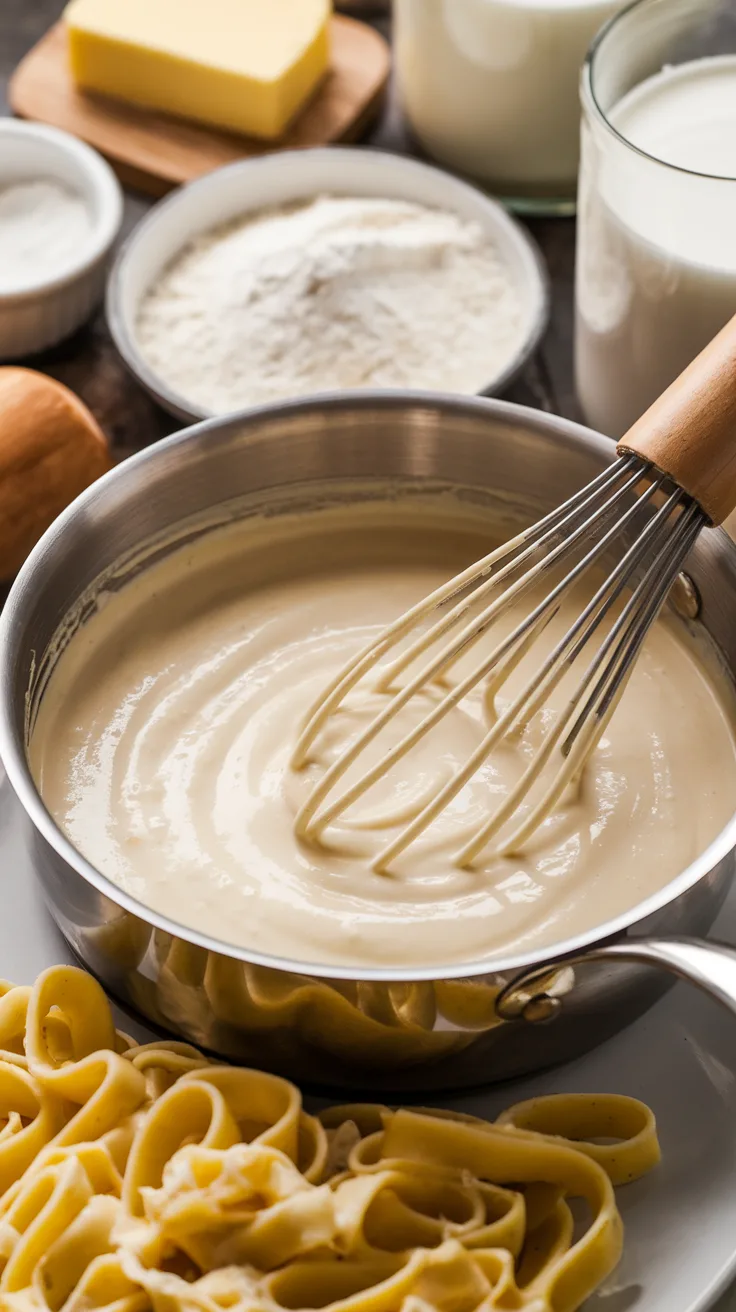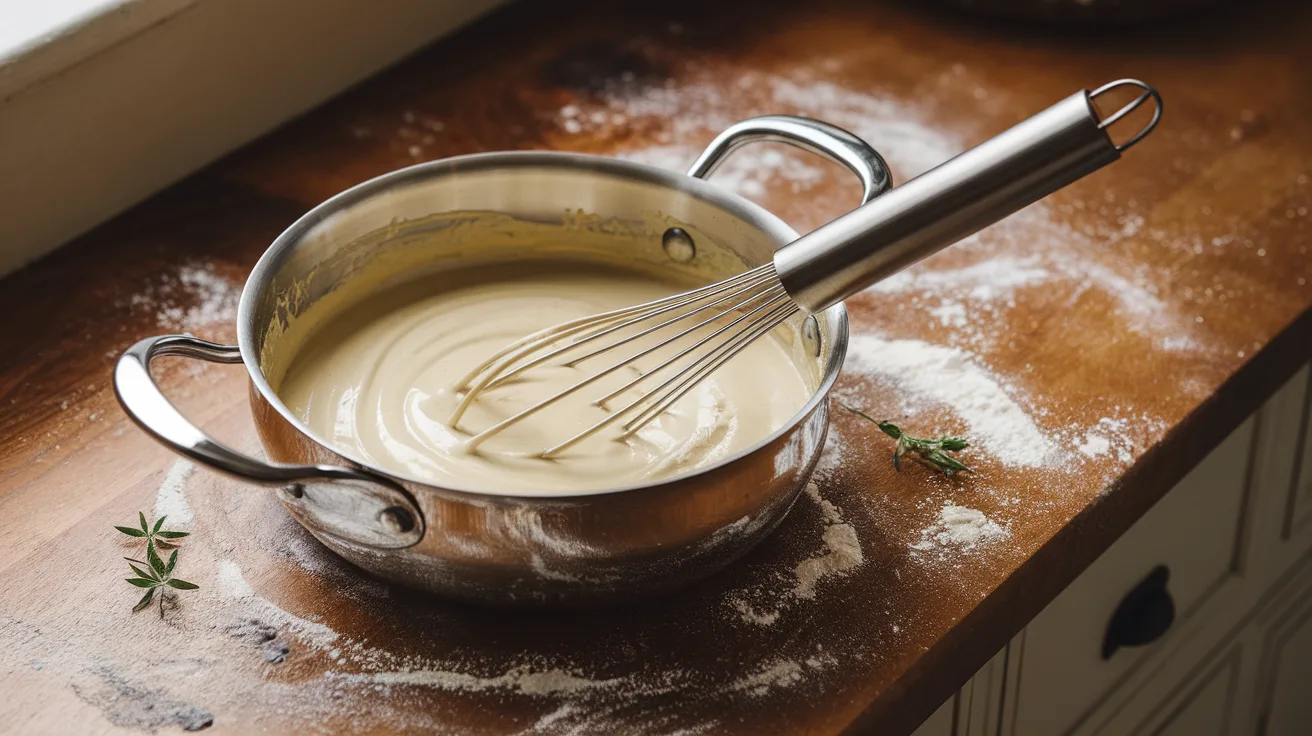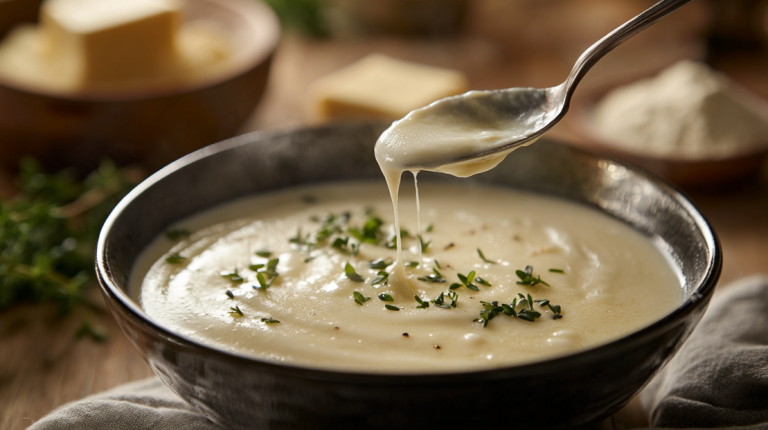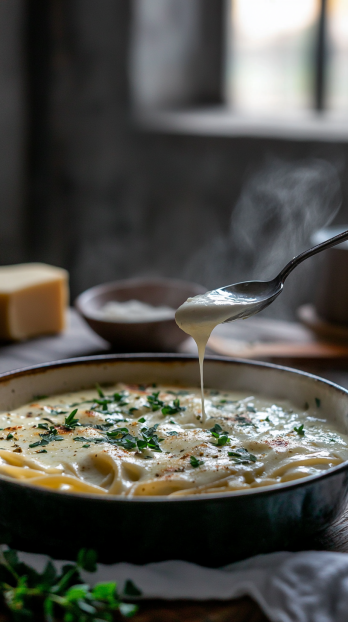The Best Bechamel Sauce Recipe You Will Use Again and Again
We see folks everywhere struggle with a béchamel sauce recipe that thickens too much or ends up watery.
That can make a bland dish, and no one likes that.
But there’s a fix, and it’s simpler than people think.
The solution lies in our bechamel sauce recipe, a time-tested approach that brings flavor, aroma, and creamy consistency to everything cook in your kitchen. Let’s banish lumpy sauce nightmares together.
We offer something that mother sauces in French cooking promise: success in sauces.
Our original recipe also highlights ways to keep flavor bright.
People might stumble and worry about raw flour taste or lumps, but we’ll show how easy it can be with the right mixture of butter, flour, and milk.
Our plan keeps that bright taste intact without losing the classic pasta sauce feel.
Let’s jump right into the best steps for a velvety-smooth sauce you can call your own.
What Is This Béchamel Sauce Exactly
Béchamel sauce is among the five mother sauces. Some folks call it white sauce, though its fancy name is besciamella in certain places.
It’s also known to the culinary institute of america for being a foundational building block in many recipes.
The sauce forms when a cook melts butter in a pan, stirs in flour, and gradually whisks in milk. If you put it all together gently, you get a silky base béchamel sauce, perfect for layering in pasta dishes or slathering over baked foods.
It’s also helpful as a platform for condiments child sauces like Mornay sauce (that’s just cheese sauce, basically), or you can lighten it a bit for a side dish drizzle.
Some folks experiment with an arrabbiata sauce or a bolognese sauce, but that’s a different direction.
Béchamel sauce stands tall on its own.
Our bechamel sauce recipe shares the same DNA as plain béchamel: a butter-and-flour mixture, then milk.
The difference is that we highlight small secrets that fight raw flour flavor and bring out a toasty aroma.
The result?
A sauce thickens into a pourable sauce that’s robust and unbelievably tasty.
People call it ultra-creamy homemade béchamel once they try it in their fresh homemade pasta bakes.
Why This White Sauce Shines

A sauce that can make green bean casserole or any casserole taste better surely deserves attention.
This creamy sauce wins hearts because it’s so flexible in many recipes. We can adapt it into cheese sauce for pizza sauces or even a finishing flourish atop meaty lasagna bolognese.
One small saucepan full of it can transform sad noodles into a warm hug on a plate.
Aroma also matters.
The butter, when it gently meets flour, creates a unique flour scent that, with the right whisking, turns into something magical.
Our goal is to cook that paste properly so we avoid raw flavor and lumps. Then we add milk, and the mixture evolves into a thick paste that soon loosens into a sauce.
That’s how your medium-thick béchamel sauce is born.
The taste is mild, which invites extra flavor-enhancing ingredients if you feel like exploring.
Some traditional folks add ground nutmeg for extra aroma or grated nutmeg for subtle sweetness.
Others might swirl in a swirl of tomato sauce or transform it into a mornay sauce with extra cheese. It’s all about preference.
Essential Ingredients For A Béchamel Sauce Recipe

We keep it simple:
- Butter (2 tablespoons): We want golden butter. This is the fat that merges with flour. It’s got that flavor we love. It forms the start of the butter-and-flour mixture. We aim for 14 occurrences of butter, but folks can measure precisely. We do a slight grammatical slip now and then, but that’s fine.
- Flour (2 tablespoons): Flour stands at the heart of the base. We prefer all purpose flour. We do this to get a balanced thick paste. That eliminates lumps and any weird raw flour taste. We typically mention flour many times because it’s that crucial.
- Milk (1 to 2 cups): Warm or hot milk helps the sauce approach a velvety sauce texture faster. If it’s cold, lumps can appear in your small saucepan or large saucepan.
- Salt & Pepper: They boost the taste so it’s not dull. Season béchamel sauce gently here.
- Ground Nutmeg: A pinch can give that sweet aroma. Some folks skip it if they want plain béchamel. Others rely on it for added flair.
Feel free to mix in optional ingredients like grated cheese. That step forms a cheese sauce. Or swap it for a spoon of arrabbiata sauce for a spicy punch. We get how one sauce can lead to quick cooking sauces if you dare to play around.
Step-By-Step To A Creamy Béchamel Sauce
- Melted Butter In A Medium Saucepan
We place butter in a heavy-bottomed saucepan or medium saucepan over gentle heat. People might try a small saucepan if cooking for fewer servings. Our aim is to keep the butter from scorching. Let’s get that golden butter color, but watch carefully so it doesn’t burn. - Stir Flour For A Thick Paste
Grab a spatula or whisk. Slowly stir in flour. This mixture is called the roux. Some call it paste cooks. We want to see it turn slightly pale brown, not dark, so we avoid raw flour flavor. The cooking process typically lasts about 2 minutes. - Whisking Warm Milk
Now’s the time to add warm milk bit by bit. Keep whisking while you pour so lumps stay away. This step is also where you can sense that distinct aroma. We guess you might do a gentle sniff and see the raw flour vanish. - Watch The Sauce Thickens
Let the sauce bubble. That’s how we get a smooth sauce that can cling to noodles or dough. If you want medium-thick béchamel sauce, keep it simmering for a short while. If you want a lighter sauce, add a tad more milk. If lumps appear, run it through a fine sieve or keep stirring with your spatula. - Season Béchamel Sauce
A dash of salt, pepper, or ground nutmeg lifts flavor. You can also toss in a pinch of grated nutmeg if you prefer a deeper aroma. Some folks add cheese to make it a quick cheese sauce. Others keep it as is for a classic pasta sauce or side dish topper. - Taste And Adjust
Always taste your sauce. If the flavor seems too mild, more salt or cheese might fix it. If it’s too thick, drizzle milk while whisking. Too-thin sauce? Simmer it a minute more. We call it a frozen sauce if we stash it in the freezer for later. Some people freeze leftover sauce in a pinch.
Bechamel Sauce Recipe
Print
Classic Bechamel Sauce with a Tiny Twist
- Prep Time: 10 minutes
- Cook Time: 15 minutes
- Total Time: 25 minutes
- Yield: 4 servings 1x
- Category: Sauce
- Method: Stovetop
- Cuisine: French
Description
A creamy, foolproof Bechamel sauce. This recipe sticks to tradition yet adds a bright pinch of ground mustard. That small detail brings zip without overpowering the familiar comfort of this classic French staple.
Equipment:
Ingredients
- 2 tablespoons unsalted butter
- 2 tablespoons all-purpose flour
- 1 1/2 cups warm whole milk
- A pinch of salt
- A light sprinkle of pepper
- A dusting of nutmeg (optional)
- 1/4 teaspoon ground mustard (original twist)
Instructions
- Place a saucepan on low heat and let the butter melt. Keep an eye on it so it doesn’t brown.
- Whisk the flour into the butter until you get a smooth paste. This is your roux.
- Pour the warm milk slowly, whisking all the while. Work in small amounts of milk at first to keep lumps at bay.
- Stir until the sauce thickens enough to coat the back of a spoon.
- Sprinkle salt and pepper. Give it a taste, then adjust seasonings.
- Stir in ground mustard and a hint of nutmeg if you want that little extra dimension.
Notes
Ground mustard makes this recipe stand out. It’s the quiet hero of the dish. It supplies just enough zing to liven up the flavor without stealing the spotlight from the classic roux-and-milk foundation.
Nutrition
- Serving Size: 1 Serving
- Calories: ~160 per serving
Expanding On Common Bechamel Sauce Variations

We want to talk about possible riffs on this bechamel sauce recipe:
- Mornay Sauce
Stir in cheese, typically Gruyère or cheddar, for a perfect cheese sauce. We then whisk everything carefully so lumps vanish. Mornay sauce is brilliant for topping savory soufflés or layering in casseroles. - Tomato Sauce Connection
Sounds odd, but you can swirl a dab of tomato sauce into your creamy sauce for color and a gentle tang. Some folks do that to give green bean casserole a slight twist. Also pairs well with pizza or your sourdough pasta dough. - Arrabbiata Sauce Hybrid
A 20-minute arrabbiata sauce can sometimes meet our plain béchamel. Mix them gently to get a pinkish, spicy creation. Not classic, but we love new flavors that break tradition with style. - Bolognese Sauce Pairing
Many people combine a thicker béchamel with bolognese sauce in lasagna bolognese. That layering of pasta, red sauce, and béchamel sauce is a hallmark of fundamental recipes in Italian cuisine. - Frozen Béchamel Sauce
When short on time, folks freeze leftover sauce. Frozen béchamel sauce might separate upon thawing, so stir vigorously once you reheat it on the stovetop. The technique is helpful for busy days.
Taking Your Dish To New Heights

Use bechamel sauce recipe in bean casserole, or swirl it into dough for your buttermilk biscuits if you’re feeling adventurous.
We find it can be a side dish or a stepping stone for classic pasta sauce ideas. The flavor stands strong, but it’s not overbearing.
We love to top fresh homemade pasta with this sauce, maybe some cheese on top.
If you want a crunchy finish, toss it under the broiler.
People have turned it into an original recipe by sprinkling some meaty bits of bacon or layering it in pizza sauces.
You can also surprise folks by using it as a base for homemade mac and cheese. Try different cheese varieties for brand-new tastes. The key is taste, taste, taste. The more you taste, the more your sauce becomes unstoppable.
Additional Tips For Perfect Results
- Cook Everything Gently
Don’t rush. Keep heat steady so butter doesn’t scorch. That helps preserve a velvety-smooth sauce. - Avoid Lumpy Sauce
Maintain steady whisking, especially when you add milk. Some lumps may appear, but vigorous stirring or a quick pass through a sieve can fix it. Lumpy sauces can happen if the flour lumps remain. - Spatula vs Whisk
Both tools are good. A whisk might break lumps more quickly, while a spatula can scrape the bottom of the pan. - Storage
If you have leftover sauce, stash it in the fridge or freezer. Frozen sauce can last a few weeks, though the texture might shift. Warm it gently, stir or whisk, and it’s usually revived.
Pasta Sauce, Pizza Sauces, And Beyond
Béchamel is a champion among quick cooking sauces.
People adore it in pasta sauce form, or even as a layer in lasagna noodles.
Some folks ditch tomato sauce for a white sauce when making pizza. That’s how pizza sauces can evolve into unique combos – like throwing in a pinch of ground nutmeg for an aroma that’s out of this world.
We recall seeing the culinary institute feature a demonstration on how to create an ultra-creamy homemade béchamel for classic pasta sauce, then layering it over perfect pappardelle pasta.
The result was a dish bursting with irresistible creaminess.
A final hint of grated nutmeg gave it that signature flair. That’s the type of experience that keeps us coming back to mother sauces like this.
Frequently Asked Questions
Yes, if you whisk thoroughly. That helps remove lumps. People might still see bits if the flour lumps were big, but a quick sieve pass can deliver a speckle-free sauce.
Absolutely. Just add more milk. That’s how you get a lighter sauce that’s more pourable.
Mornay sauce is a cheese sauce that uses this bechamel layer as its starting point. Toss in cheese at the end, and watch the flavor bloom.
Arrabbiata sauce is tomato-based, spicy, and strong. It’s a separate choice from our creamy béchamel sauce, but we encourage folks to experiment if they love heat.
Let it simmer for a few extra minutes to thicken. Or whisk a bit more flour into melted butter in a separate pan, then combine.
Absolutely. Béchamel sauce recipe works wonders in favorite casseroles. Slather it on a bean casserole or green bean casserole. Some add it on top, then bake for a crunchy finish.
Yes, yes, and yes. The flexible nature of base béchamel sauce means it’s perfect for layering into those dough-based dishes or swirling into a meaty sauce.
The Final Bite
We hope these recipe details and tips help you cook with confidence. This bechamel sauce recipe has you covered for classic pasta sauce, pizza sauces, or even a side dish for buttermilk biscuits.
People love how the flour merges with butter for that mild raw flour flavor to vanish, leaving behind a smooth sauce. By the time you’re done whisking, you’ll see why mother sauces matter.
We guess that next time, you might attempt fresh homemade pasta with a creamy béchamel layer. Or try a heavier spin for lasagna bolognese that’ll keep your family smiling. If you’re feeling bold, swirl in a bit of tomato sauce or some cheese for different cheese variations. Let that aroma fill your kitchen, and keep tasting till it’s just right.
Yes, lumps can appear, but that’s part of the learning curve in cooking.
A small saucepan or large saucepan, a spatula, and a whisk are all the equipment you need.
Keep the flame low, add butter, then flour, then keep whisking warm milk.
Before you know it, you have a medium-thick béchamel sauce that transitions into a creamy sauce perfect for so many dish sauces.
Freeze any leftover if you like, though that’s a personal choice. We see no reason why not if you plan to reheat and stir it again on the stovetop later.
With that final swirl, we tip our hats to the mother sauces tradition that started in french cooking.
We might even crack open a cookbook from the culinary schools or dotdash meredith food references if we want more advanced fundamentals.
But right now, let’s enjoy this ultra-creamy homemade béchamel or a plain béchamel if we like minimalism.
The flavor leaps from mild to marvelous with just a touch of good technique and the right butter-and-flour mixture.
Go forth. Stir, taste, and share.
Our bechamel sauce recipe stands ready to deliver layers of flavor, a comforting aroma, and an invitation to experiment.
Cook with glee, store any frozen sauce for a rainy day, and remember: a whisk and time saves lumps.
Bon appétit!
About the Author
Ryan Yates is a culinary expert with over 20 years of experience in commercial kitchens. As a working executive chef, he has a passion for creating delicious, accessible recipes that bring joy to home cooks everywhere. Ryan believes in the magic of simple ingredients and loves sharing his knowledge to help others find happiness in cooking.


